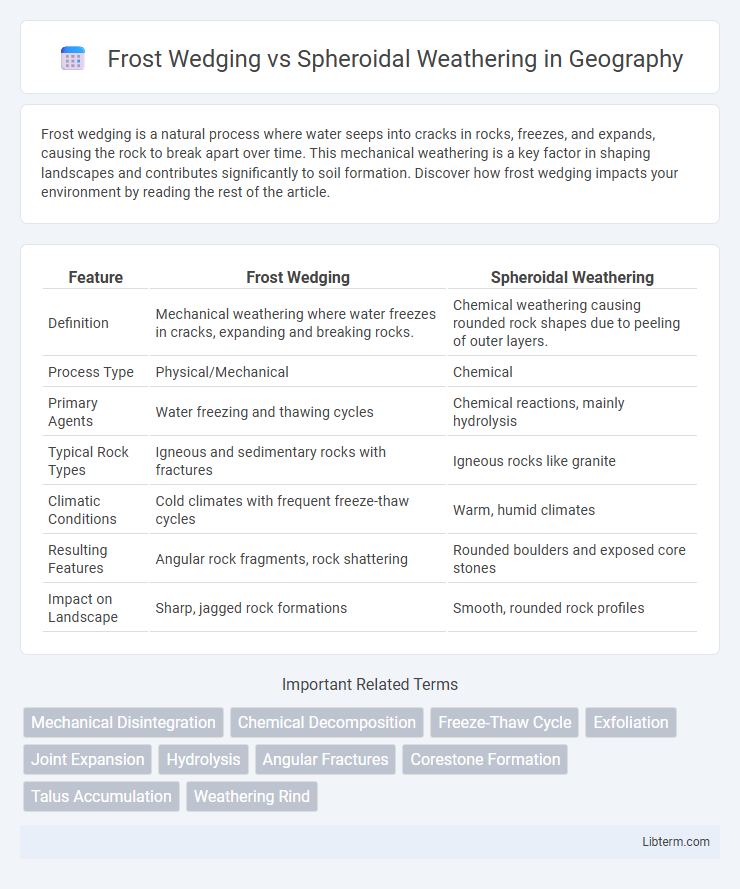Frost wedging is a natural process where water seeps into cracks in rocks, freezes, and expands, causing the rock to break apart over time. This mechanical weathering is a key factor in shaping landscapes and contributes significantly to soil formation. Discover how frost wedging impacts your environment by reading the rest of the article.
Table of Comparison
| Feature | Frost Wedging | Spheroidal Weathering |
|---|---|---|
| Definition | Mechanical weathering where water freezes in cracks, expanding and breaking rocks. | Chemical weathering causing rounded rock shapes due to peeling of outer layers. |
| Process Type | Physical/Mechanical | Chemical |
| Primary Agents | Water freezing and thawing cycles | Chemical reactions, mainly hydrolysis |
| Typical Rock Types | Igneous and sedimentary rocks with fractures | Igneous rocks like granite |
| Climatic Conditions | Cold climates with frequent freeze-thaw cycles | Warm, humid climates |
| Resulting Features | Angular rock fragments, rock shattering | Rounded boulders and exposed core stones |
| Impact on Landscape | Sharp, jagged rock formations | Smooth, rounded rock profiles |
Introduction to Frost Wedging and Spheroidal Weathering
Frost wedging is a mechanical weathering process where water infiltrates cracks in rocks, freezes, and expands, causing the rock to break apart over time. Spheroidal weathering is a chemical and physical weathering process that rounds off angular rock edges by differential weathering of minerals, often resulting in spherical boulder formations. Both processes significantly contribute to the breakdown and reshaping of bedrock in various geological environments.
Definition of Frost Wedging
Frost wedging is a mechanical weathering process where water seeps into cracks, freezes, and expands, causing the rock to fracture and break apart. This phenomenon primarily occurs in climates with frequent freeze-thaw cycles, leading to significant physical disintegration of rock formations. In contrast, spheroidal weathering is a chemical weathering process that rounds rock edges through the gradual removal of minerals, typically affecting rock surfaces exposed to moisture and air.
Definition of Spheroidal Weathering
Spheroidal weathering is a chemical weathering process where water penetrates rock joints, causing concentric layers to peel off and produce rounded boulders, often seen in granitic rocks. Unlike frost wedging, which is a physical process driven by water freezing and expanding in cracks, spheroidal weathering alters the rock's mineral composition through hydrolysis and oxidation. This weathering type results in characteristic spheroidal shapes due to the differential chemical breakdown of rock corners and edges.
Causes and Mechanisms of Frost Wedging
Frost wedging occurs when water enters rock cracks, freezes, and expands by approximately 9%, exerting pressure that enlarges the fractures over repeated freeze-thaw cycles. This mechanical weathering process is driven by temperature fluctuations around the freezing point, particularly in climates with frequent freeze-thaw events. Unlike spheroidal weathering, which involves chemical alterations and rounding of rock edges due to hydration and oxidation, frost wedging primarily relies on physical expansion forces to break rocks apart.
Causes and Mechanisms of Spheroidal Weathering
Spheroidal weathering occurs primarily due to chemical weathering processes, where water infiltrates rock joints and decomposes minerals like feldspar into clay, rounding off angular edges over time. This mechanism contrasts with frost wedging, which is driven by physical expansion as water freezes and thaws, fracturing the rock along cracks. The chemically altered outer layers peel away progressively, resulting in characteristic rounded boulders typical of spheroidal weathering.
Key Differences Between Frost Wedging and Spheroidal Weathering
Frost wedging occurs when water infiltrates rock cracks, freezes, and expands, causing mechanical disruption primarily in cold climates, whereas spheroidal weathering is a chemical process that rounds off rock edges through the gradual decomposition of minerals, typically in humid environments. Frost wedging leads to physical fragmentation without changing the rock's chemical composition, while spheroidal weathering alters the rock's mineralogy by promoting chemical reactions such as hydrolysis. The key differences lie in their mechanisms--mechanical versus chemical weathering--as well as their climatic conditions and effects on rock texture and form.
Geological Environments Favoring Each Process
Frost wedging predominates in cold climates where repeated freeze-thaw cycles cause rock fracturing, typically in mountainous or high-latitude regions with abundant water infiltration. Spheroidal weathering occurs in warm, humid environments where chemical weathering processes, such as oxidation and hydrolysis, gradually round rock edges, often seen in tropical or subtropical settings with deep soil profiles. These distinct geological settings determine the dominance of physical disintegration via frost wedging or chemical alteration through spheroidal weathering.
Effects on Rock Structure and Landscape Formation
Frost wedging fractures rocks by repeated freeze-thaw cycles, creating angular rock fragments and contributing to mechanical weathering that forms talus slopes and jagged landscapes. Spheroidal weathering chemically alters rock, rounding edges by peeling off successive layers, typically in jointed, coarse-grained rocks like granite, leading to rounded boulders and smooth hilltops. These distinct processes shape diverse terrain features, with frost wedging enhancing physical disintegration and spheroidal weathering promoting chemical decomposition and landscape smoothing.
Examples of Locations Impacted by Each Weathering Type
Frost wedging prominently affects regions with frequent freeze-thaw cycles such as the Adirondack Mountains in New York and the Rocky Mountains in Colorado, where water seeps into rock cracks, freezes, and causes expansion leading to rock fragmentation. In contrast, spheroidal weathering is commonly observed in tropical and subtropical areas like the granite landscapes of the Sierra Nevada in California and the basement complex terrain of Kenya, where chemical weathering rounds off rock edges creating characteristic onion-like layers. These distinctive environmental conditions drive the prevalence of each weathering type, shaping the geological features of their respective regions.
Importance in Earth’s Geological Cycle
Frost wedging plays a critical role in the Earth's geological cycle by mechanically breaking down rocks through the repeated freezing and thawing of water in cracks, accelerating physical weathering and soil formation. Spheroidal weathering contributes to the geological cycle by chemically weathering rocks into rounded shapes, facilitating the breakdown of bedrock into smaller particles and influencing landscape evolution. Both processes are essential in shaping Earth's surface, driving sediment production, and influencing rock cycle dynamics.
Frost Wedging Infographic

 libterm.com
libterm.com